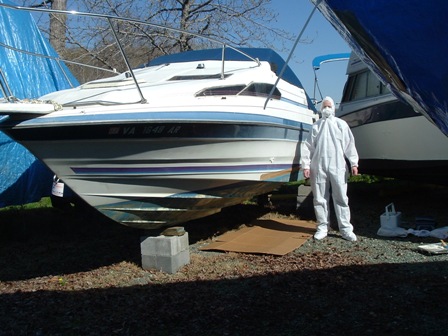
*Tyvek Suit and N100 Facemask*
With the very real possibility of needing to actually don and use all those Tyvek zoot suits and N100 facemasks Iíve been buying, I thought it would be a good idea to see how well I could work in them. Specifically, I wanted to know;
I needed to apply new bottom paint to our boat this year and thought that this would be a pretty good real life test since this would be done outside in less than ideal conditions. For this test, I decided not to go the full route of using gloves and taping seams since I had no actual way to measure infiltration anyway. Iím just going to have to trust that in an NBC situation gloves and tape will do what theyíre supposed to do.
The Tyvek suits I stock have booties and a hood permanently attached and use a half-length front zipper. It took less than one minute to don the suit. It took nearly two minutes to get the 3M, N100 mask on because out of the bag the elastic straps are not already threaded through the plastic clips that hold them. Good lesson learned here, for quick deployment with BOB or BOV, I will pre-thread the straps and then heat seal the facemasks back in the bags. I also had to allow about 30 seconds to form the mask to my face for the best fit.

Here I am at the marina, all suited up and ready to work. Normally there wouldnít be anyone around early Sunday morning but as luck would have it my slip neighbor was there working on his boat as well. Heís an engineer and hardly even made a comment J That brown stuff in the picture are thousands of prickly seed pods off of the trees in the background. Theyíre sharp and usually stick to anything but they didnít stick to the Tyvek suit, nor did they punture it.
It took 1.5 hours to paint the bottom of the boat. The temperature was 65F. The Sun was shining brightly and humidity was low. Hereís what I learned.
So to summarize, I tested actually doing moderate work in a Tyvek suit and N100 facemask for 1.5 hours outside in 65F temperature and low humidity. It worked fine and I didnít suffer any particular discomfort, although if the temperature or humidity were higher I would have needed to shorten the exposure time or risk dehydration.
Spitfire
www.alpharubicon.com
All materials at this site not otherwise credited are Copyright © 1996 - 2005 Trip Williams. All rights reserved. May be reproduced for personal use only. Use of any material contained herein is subject to stated terms or written permission.